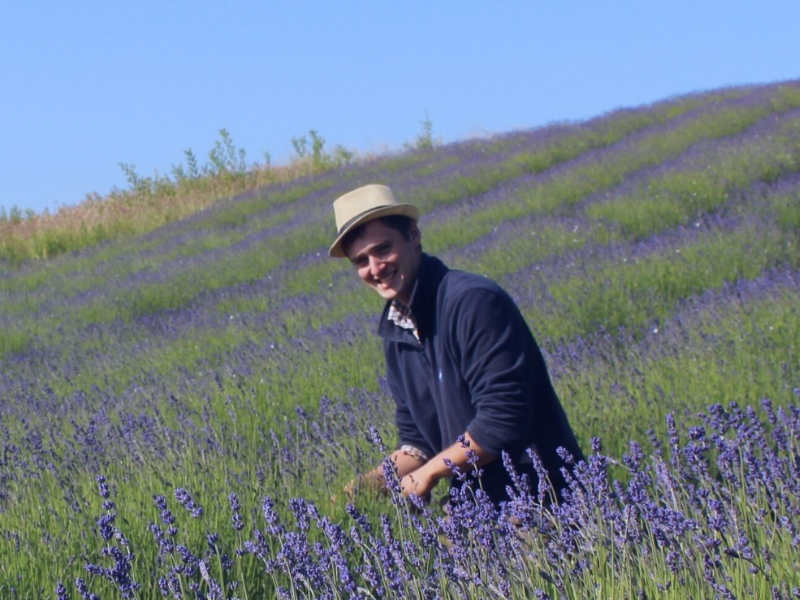ALUMNI STORIES: FROM SCOTS LAW TO SCOTTISH LAVENDER OILS

ALUMNI STORIES: FROM SCOTS LAW TO SCOTTISH LAVENDER OILS
Rory Irwin (St Anne's, 2013) talks about his time at Oxford and swapping Scots Law to focus on diversifying the family-run farm.
Published: 7 May 2024
Author: Zoe Burns
Share this article
What inspired you to study at Oxford?
I’d never seriously considered applying to a university such as Oxford. In fact, I only became interested in the sciences in the later years of senior school. The decision to apply was spontaneous, and I was genuinely surprised, and thrilled, to receive an offer. It was the potential for an all-encompassing lifestyle and its academic reputation that convinced me to attend Oxford over other universities.

Rory performing at open mic night in St Anne's Bar in 2013
What are some of your favourite memories of your time at Oxford?
My favourite memories are rooted in the people I met along the way. At St Anne’s, living and studying on-site throughout the course fostered a strong sense of community. I was fortunate to be part of a small supportive Physics group who were invaluable over the three years. Weekly lab sessions with my lab partner offered a refreshing break from textbooks.
Beyond academics, memories such as the varsity ski trip, founding the Scottish Society, and a self-organised camping trip to Cornwall after the first year (the drive from Fife was longer than I anticipated) are highlights.
How do you think Oxford changed you?
The tutorial system was invaluable. Whereas in school it was possible to get by without truly understanding a concept, it is quite different sitting across from a professor. This instilled the confidence to approach problems thoughtfully and fully.
The demanding schedule required careful balance of academic and extra-curricular commitments. Looking back, I am sure this cultivated discipline and a sense of self-accountability.
Finally, it was fascinating to spent three formative years with such interesting and impressive individuals, all with different perspectives and backgrounds.
Tell us about your journey, from studying at Oxford to becoming the owner of Scottish Lavender Oils.
During the year after graduating, I worked as a paralegal in Edinburgh and in the evenings as a private Physics and Maths tutor. I then moved to Bristol to take an accelerated law conversion course. The option to study the equivalent course in Scots law (allowing me also to qualify in Scotland) came available online, allowing me to juggle the two degrees together.
I was fortunate to secure two summer internships in law but turned down the opportunity to move onto a training contract. At this point, alongside a family illness that necessitated my return, I was becoming interested in the cultivation, distillation and accreditation of essential oils, particularly within the UK. I reasoned that while I could probably return to a legal career after exploring this industry, the reverse would be more difficult.
What are the biggest challenges that you have faced during the process of setting up Scottish Lavender Oils? How did you overcome these?
The key challenge in growing lavender in Scotland is the climate. Lavender grows best in conditions found in the south of England or in France. Growing strong, healthy plants required new initiatives, such as creating raised beds of sandy soil to improve drainage.
A more general observation is the difficulty in entering a completely new industry. This is true both in the agricultural side of the business – as there are no other growers of aromatic plants this far north – and the side of the business relating to essential oils and perfumes. I’ve spent a huge amount of time skimming textbooks and online forums!
Tell us about Tarhill Farm and Scottish Lavender Oils.
Tarhill Farm is an arable farm beside Loch Leven and bordering the National Nature Reserve. As most of the ground is rented out, the required investment in machinery is minimised.
Scottish Lavender Oils is the business that relates to the growing and distilling of aromatic plants (such as the lavender), and perfumery. The business supplies high street brands alongside its own range of products. The farm’s unique position so far north has led to collaboration with various universities throughout Europe investigating the chemical properties of different essential oils. The lavender also attracts day tourists throughout the summer months.
Since taking on the Tarhill Farm site near Kinross, how have you been managing the farm to boost biodiversity?
The wider farm has changed hugely over the last eight years. Native hedgerows have been re-established, poor quality areas have been set permanently aside from agricultural operations, and a new lochan is starting to mature. The increase in wildlife and passerines is apparent. As the surrounding area has been intensively farmed since the middle of the last century, many of the feature traditionally associated with the Scottish countryside have been lost. I hope that by making small, yet consistent, changes, we can do our part to restore the landscape.
For the farm to survive financially into the future, we needed a project that would generate income aside from standard agricultural activities.
What was the inspiration behind diversifying to grow lavender on the farm?
Firstly, we identified that the farm is not of sufficient size to operate competitively into the future. The cost of equipment and labour is prohibitive, and operating expenses continue to rise. The agricultural system of subsidies is also changing, and it is unclear how this might affect landholdings like ours. For the farm to survive financially into the future, we needed a project that would generate income aside from standard agricultural activities.
Secondly, the area of ground now dedicated for aromatic plants is some of the least suitable ground on the farm for typical arable farming due to the slope and sandy soil. The opportunity to diversify into aromatic plants without incurring significant lost income was a key factor.
Any plans for expanding the farm further or growing other aromatic crops for your perfume brand?
We grow several other crops alongside lavender, including different varieties of mint, sage, and chamomile. I would like to concentrate on the quality of our oil rather than trying to expand too quickly. We are at a manageable size whereby manual maintenance and harvesting can be sustained. By concentrating on growing unique varieties of plants, we can maintain the high standards required for use in fine perfumery.

How is this year's lavender looking, and when are you expecting full bloom?
They’re just waking up after winter and fresh green foliage is starting to appear. As I write this in early May, it always amazes me that in just two months’ time the plants will begin to flower. Full bloom in central Scotland occurs at the end of July to late August, though this can change every year.
Tell us about the lavender distillation process to transform lavender into essential oils.
Distillation is a process that spans several years. Scottish Lavender Oils’ focus is on producing small quantities of exceptional quality oil, so we have had to refine each stage of the process.
The first task is to choose both the variety and source of lavender. The variety of lavender influences its robustness, oil yield, and oil quality; and the source of the lavender plants will determine how they may have been selectively bred to enhance these qualities./
Once the plants have been identified, they are planted in raised beds and first harvested in their third year. The long daylight hours and south-facing, sloped field create strong root systems. All the plants are hand-harvested using traditional methods to ensure that only pure lavender flowers and stems make it to the distillery. A copper alembic still is used to distil the plants through an unpressurised system, creating an exceptional quality of oil.
This process is repeated for our other aromatic plants, and the essential oils are used in our perfume brand, St Andrews Perfumery.
What do you think would be the best way to encourage farmers to adopt sustainable farming practices?
There is a fascinating discussion at present about how to balance the issues relating to the future of farming. Careful consideration is needed to ensure that the sector is sustainable, competitive, and capable of meeting future domestic and international challenges. I can only give a general thought here.
Family farmers usually have a long-term interest in their land as a farm is typically kept within the same family across generations. Large farms, owned by institutions, will be primarily concerned with the financial yield underpinning their investment. Financial support systems and regulation are required until sustainable methods become profitable.
The issue is in establishing the conditions of financial support and the goal of regulation. There must be a consistent consensus on the direction of policy to allow farms to invest over many years.
Scottish Lavender Oil is situated in the heart of Central Scotland's Kinross-shire countryside. Daily tours operate during August.
Lavender Oils are used exclusively in the luxury perfume brand, St Andrews Perfumery.
Connect with Rory Irwin on LinkedIn















